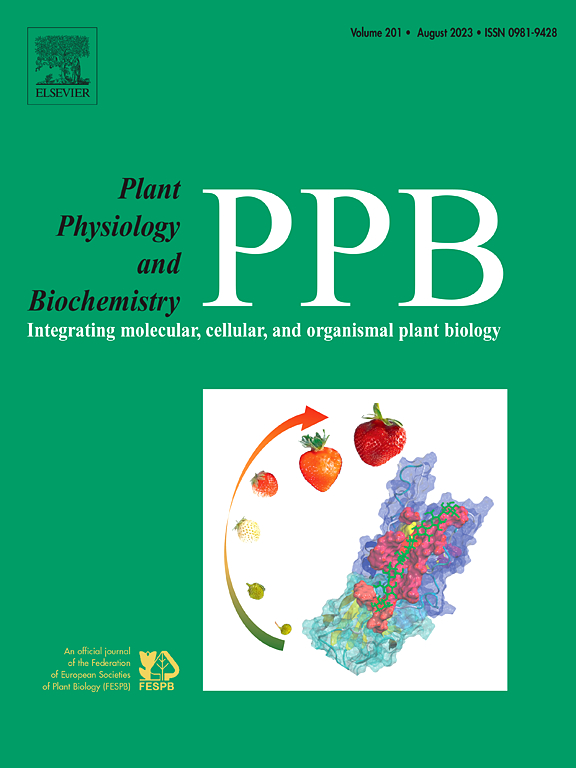小麦YSL15-6B通过调控镉出口调控籽粒镉浓度
IF 6.1
2区 生物学
Q1 PLANT SCIENCES
引用次数: 0
摘要
镉(Cd)是一种对所有生物都有毒的重金属。小麦籽粒累积镉的增加对人体健康构成严重威胁。因此,降低小麦籽粒镉浓度是保障粮食安全和人类健康的迫切需要。在这里,我们发现小麦黄色条纹样蛋白15 (YSL15-6B)控制着籽粒Cd浓度。方法分析小麦YSL15-6B突变系和过表达系的表达模式、亚细胞定位、Cd转运活性和Cd积累情况。结果从波兰矮小麦(Triticum polonicum L. 2n = 4x = 28, AABB)中克隆的stpysl15 - 6b主要在根和叶中表达。其蛋白定位于原生质体的内质网和质膜。Cd- na胁迫下酵母中TpYSL15的表达增加了Cd浓度。Kronos中TtYSL15-6B的功能缺失增加了Cd的吸收、根到茎的Cd转运和籽粒Cd浓度。同时,Ttysl15-6B突变系与宽型相比,TtNRAMP5和TtHMA2表达上调,TtZIP1表达下调。TpYSL15-6B在水稻中的过表达导致Cd从根部输出,并限制了Cd在根尖间的转运和籽粒Cd浓度。tpysl15 - 6b过表达系与宽型ZH11相比,OsZIP1和OsABCG36表达上调,OsIRT1和OsNRAMP2表达下调。结论小麦YSL15-6B调控植物Cd输出。这些结果为限制小麦籽粒镉浓度和镉转运的生理途径提供了新的基因和见解。本文章由计算机程序翻译,如有差异,请以英文原文为准。

Wheat YSL15-6B underlies grain cadmium concentration via governing cadmium export
Background
Cadmium (Cd) is a toxic heavy metal for all organisms. Increasing of wheat grain accumulates Cd posing a serious risk to human health. Thus, reducing grain Cd concentration of wheat is urgently required for food security and human health. Here, we found a wheat yellow stripe-like protein 15 (YSL15-6B) governs grain Cd concentration.
Methods
The expression pattern, subcellular localization, Cd transport activity and Cd accumulation in mutant and overexpressing lines of wheat YSL15-6B were analyzed.
Results
TpYSL15-6B, cloned from Dwarf Polish wheat (Triticum polonicum L. 2n = 4x = 28, AABB), was mainly expressed in roots and leaves. Its protein was localized at the endoplasmic reticulum and plasma membrane in protoplast. Expression of TpYSL15 in yeast increased Cd concentration under Cd-NA stress. Loss-of-function of TtYSL15-6B in ‘Kronos’ increased Cd uptake, root-to-shoot Cd translocation, and grain Cd concentration. Meanwhile, Ttysl15-6B mutant line exhibited up-regulation of TtNRAMP5 and TtHMA2, and down-regulation of TtZIP1 when compared with the wide type. Overexpression of TpYSL15-6B in rice caused Cd exporting from roots, and limited root-to-shoot Cd translocation and grain Cd concentration. TpYSL15-6B-overexpressing lines showed up-regulation of OsZIP1 and OsABCG36, and down-regulation of OsIRT1 and OsNRAMP2 when compared with the wide type ZH11.
Conclusion
wheat YSL15-6B governs Cd export from plant. These results provide a new gene and insight for limiting grain Cd concentration in wheat and the physiological pathway of Cd transport.
求助全文
通过发布文献求助,成功后即可免费获取论文全文。
去求助
来源期刊
CiteScore
11.10
自引率
3.10%
发文量
410
审稿时长
33 days
期刊介绍:
Plant Physiology and Biochemistry publishes original theoretical, experimental and technical contributions in the various fields of plant physiology (biochemistry, physiology, structure, genetics, plant-microbe interactions, etc.) at diverse levels of integration (molecular, subcellular, cellular, organ, whole plant, environmental). Opinions expressed in the journal are the sole responsibility of the authors and publication does not imply the editors'' agreement.
Manuscripts describing molecular-genetic and/or gene expression data that are not integrated with biochemical analysis and/or actual measurements of plant physiological processes are not suitable for PPB. Also "Omics" studies (transcriptomics, proteomics, metabolomics, etc.) reporting descriptive analysis without an element of functional validation assays, will not be considered. Similarly, applied agronomic or phytochemical studies that generate no new, fundamental insights in plant physiological and/or biochemical processes are not suitable for publication in PPB.
Plant Physiology and Biochemistry publishes several types of articles: Reviews, Papers and Short Papers. Articles for Reviews are either invited by the editor or proposed by the authors for the editor''s prior agreement. Reviews should not exceed 40 typewritten pages and Short Papers no more than approximately 8 typewritten pages. The fundamental character of Plant Physiology and Biochemistry remains that of a journal for original results.

 求助内容:
求助内容: 应助结果提醒方式:
应助结果提醒方式:


